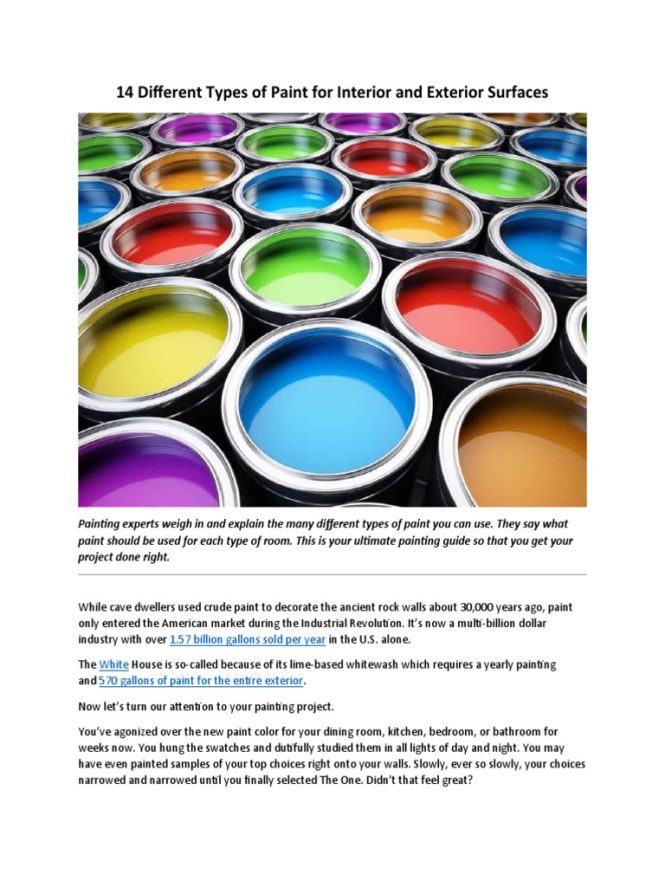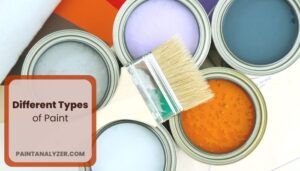

Understanding Different Types of Paint is essential for any painting project, whether it’s a simple touch-up or a complete home renovation. Imagine embarking on a home improvement project, only to find the paint you selected doesn’t meet your expectations. Fading colors, uneven surfaces, or premature deterioration can ruin your hard work and aesthetic goals. Choosing the correct paint type is critical for achieving the desired look, durability, and performance. This comprehensive guide will explore the diverse spectrum of paint types, highlighting their unique characteristics, applications, and advantages. We will delve into the specifics of different paint types, examining their strengths and weaknesses, ultimately equipping you with the knowledge to make informed decisions about your next painting project.
Introduction to Different Paint Types
Exploring the World of Paint
Understanding the nuances of various paint types is paramount in successful painting projects. Paint, a ubiquitous material in construction and home improvement, comes in a multitude of forms, each designed for specific applications and environmental conditions. From the classic oil-based paints to the modern water-based options, the market offers a wide range of choices. This exploration will delve into the different paint types, highlighting their advantages, disadvantages, and ideal use cases. Understanding these aspects will enable you to make well-informed decisions, ensuring you select the paint that best suits your project’s needs.
Different Painting Applications
Different paints are better suited for different applications. For example, exterior paints must withstand harsh weather conditions, while interior paints often prioritize aesthetic appeal and easy maintenance. Interior paints can range from simple matte finishes to high-gloss finishes, allowing for creative design choices. Exterior paints, due to their need for resilience against the elements, often come in more durable and weather-resistant formulations.
Oil-Based Paints: A Timeless Classic
Historical Significance and Properties
Oil-based paints have been a cornerstone of painting for centuries. Their rich history stems from the inherent properties of oil-based paints, derived from linseed oil and similar compounds. These paints offer excellent durability and a wide range of finishes. However, their solvent-based nature often necessitates appropriate ventilation during application.
Advantages and Disadvantages
One of the primary advantages of oil-based paints is their exceptional durability and ability to withstand wear and tear, making them well-suited for high-traffic areas. Their deep, rich color is a significant advantage. However, their solvent-based nature results in a strong odor, posing concerns for individuals with respiratory sensitivities or those working in confined spaces. Oil-based paints can also take a longer time to dry, which necessitates careful planning and scheduling.
Latex Paints: Modern Favorites
Advantages and Applications
Latex paints, also known as acrylic or water-based paints, are extremely popular for their ease of use and environmental friendliness. Their water-based nature means they are generally low-odor and easy to clean up, making them ideal for both professional and DIY projects. Latex paint is a favorite choice for interior walls and various other surfaces due to its versatility and relatively quick drying time.
Types of Latex Paints
Various formulations of latex paints exist, catering to specific needs. For instance, satin latex paints provide a smooth, slightly reflective finish. Semi-gloss latex paints strike a balance between durability and visual appeal, often favoured in high-traffic areas. Gloss latex paints are exceptionally durable and highly reflective, ideal for areas where high moisture resistance is paramount.
Acrylic Paints: A Versatile Option
Applications and Properties
Acrylic paints, a subset of latex paints, are renowned for their versatility and vibrant color options. Their water-based nature makes them a popular choice for artists, craftspeople, and DIY enthusiasts alike. Acrylic paints can be applied to a wide variety of surfaces, showcasing an impressive ability to adhere effectively.
Advantages and Disadvantages
Acrylic paints offer a wide range of colors and finishes. Their water-based nature makes them easy to use and clean up, with minimal environmental impact. However, they may not be the best choice for high-moisture environments, as they might be prone to cracking and peeling in certain situations.
Exterior Paints: Protecting Your Home
Characteristics and Durability
Exterior paints are specifically formulated to withstand the elements. These paints are designed to resist rain, sun, and other environmental factors, prolonging the lifespan of your home’s surfaces. Understanding the different types of exterior paint is critical for selecting the right one for your unique home or building.
Types of Exterior Paint
Exterior paints come in various types, each designed for specific needs. For example, paints with enhanced mildew resistance are beneficial in humid climates. Paints designed to resist fading from UV exposure are crucial in areas with high sun exposure. Choosing the appropriate exterior paint can extend the life of your property and ensure its continued aesthetic appeal.
Choosing the Right Paint for Your Needs
Factors to Consider
The decision of which paint to choose should be based on a variety of factors. Consider the intended use and application of the paint. Different paint types are designed for different purposes, from interior walls to exterior siding. Consider the level of maintenance required and the aesthetic preferences for your project. Research the characteristics and attributes of each type to ensure it meets the specific demands of the project. Ultimately, the best choice is the one that provides optimal performance, durability, and aesthetic value.
Research and Comparison
Thorough research and comparisons are critical. Inspect the product’s specifications for relevant data, such as the paint’s water-resistance, durability, and ease of maintenance. Consult paint retailers or experts for advice. Read reviews from fellow consumers to glean insights into practical experiences and potential downsides.
Choosing the Best Paint Brands
Researching Reputable Brands
Investing in reputable paint brands is often a worthwhile investment. Extensive research on different paint brands can provide you with critical insights into the quality of their products. Look for brands with a history of reliability and a proven track record in the industry.
Reviews and Expert Opinions
Reading reviews and consulting with painting experts can significantly impact your decision-making process. Expert insights offer valuable perspectives, guiding you to the most suitable paint for your needs. Analyzing user reviews can reveal insights into paint quality, durability, ease of application, and environmental impact. Look for certifications and recognized quality marks as well.
Preparing Your Surface for Painting
Surface Preparation
Proper surface preparation is an integral part of successful painting. A smooth, clean, and properly prepared surface promotes even paint application, maximizing its effectiveness and durability.
Surface Cleaning and Repair
Surface cleaning is a vital step in ensuring successful painting. Thoroughly clean the surface to eliminate dust, dirt, or debris, which can negatively impact paint adhesion. Repairing any cracks, holes, or imperfections is necessary to promote a smooth and uniform finish.
Frequently Asked Questions
What are the key differences between oil-based and latex paints?
Oil-based paints typically offer superior durability and a wide range of finishes, but they often have a strong odor and longer drying times. Latex paints, on the other hand, are generally low-odor, dry quickly, and are easier to clean up. The choice often comes down to the specific needs of the project and the environmental considerations. The long-term durability and weathering resistance of oil-based paints make them ideal for exterior applications, while latex paints are preferable for interior use and quick projects.
How do I choose the right paint for my home exterior?
Choosing the right exterior paint depends on the specific climate and environmental conditions of your home. Areas with high humidity may require mildew-resistant paints. Homes exposed to significant sun exposure need paints with UV resistance. Consult a paint professional for recommendations tailored to your specific region and environmental considerations. Researching local paint brands and their recommendations for your specific climate is crucial for ensuring long-term paint protection and beauty.
In summary, understanding different paint types is crucial for achieving desired results in any painting project. Whether you’re a seasoned DIY enthusiast or a professional painter, knowing the properties and characteristics of various paints – from latex to oil-based paints – empowers you to make informed decisions. Choosing the right paint type ensures optimal performance, longevity, and the aesthetic appeal you envision. For more detailed guidance, consult reputable painting resources and consider taking a professional painting course. This knowledge empowers you to tackle any painting project with confidence and achieve outstanding results.